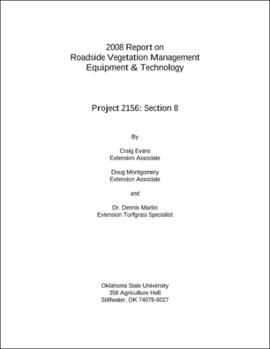| dc.description.abstract | The objective of this report is to provide Oklahoma Department of Transportation (ODOT) personnel with recommendations concerning the utilization of new technologies that will enable vegetation managers to provide safe travel corridors for Oklahoma抯 motoring public. ODOT highway easement managers continue a long term integrated roadside vegetation management (IRVM) program. This program maintains suitable vegetation to stabilize soil, allow for surface drainage and allow suitable site distance for the motorist. The integrated program is based on use of suitable vegetation types and its long-term maintenance through mowing and herbicide use. These practices are used to not only keep vegetation within the height requirements but reduce competition from undesirable weeds that compete with low growing grass vegetation. A wide range of soil types, climatic variation and plant species are present on roadsides. Consequently, ODOT personnel must utilize many different herbicidal tools for specific management goals. Regardless of which herbicidal tool is employed, the means of transferring an herbicide product between its original container and the spray tank has remained basically unchanged for many years. Two concerns have always been present for herbicide product end-users: 1. What to do with the empty container? 2. What can be done to lower handler/mixer exposure risk? When ODOT selects a liquid herbicide product, the product has typically been packaged in non-refillable high density polyethylene (HDPE) containers of varying size by the manufacturer. Manufacturers supplied these products to distributors, whom then sold the product to their clients (ODOT). At the 2008 National Roadside Vegetation Management Association (NRVMA) meetings, Nancy Fitz of the U.S. Environmental Protection Agency (EPA) presented information concerning current and future regulation affecting herbicide manufactures. These regulations encourage the use of refillable containers in agricultural or professional specialty herbicide markets. More specific information can be found in the US EPA Pesticide Container and Containment Rule, October 2008 at http://www.epa.gov/pesticides/regulating/containers.htm. Recently a partnership has arisen between forward thinking herbicide manufactures and custom blending/repackaging services to facilitate EPA goals of reducing the number of improperly rinsed HDPE herbicide containers sent to land-fill sites. Additionally, end-users of herbicide products are actively employing new transfer technology (closed-loop systems) that minimize employee exposure. Additionally, the mechanized transfer systems that use various pumping configurations are reported by the manufacturers as saving time, labor costs and reduce heavy lifting related injury claims. | |
